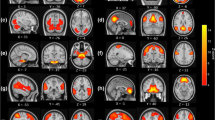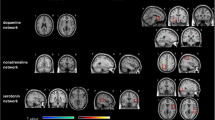Abstract
This study investigated the aberrant connectivity of the salience network (SN) and default mode network (DMN) and the relevance between these abnormalities and symptom improvement in hyperthyroid patients using resting-state functional magnetic resonance imaging (rs-fMRI). Seed-based functional connectivity (FC) analyses were performed on state fMRI data to reveal possible differences in critical node connectivity in the SN and DMN between 41 new-onset, untreated hyperthyroid patients and 41 healthy controls. Subsequently, follow-up data were available for 25 patients treated with methimazole for one month. Compared with the healthy controls, the patients exhibited abnormal internetwork FC from the SN to the DMN and the executive control network (ECN) and decreased intra-network FC within the SN. Relative to the hyperthyroid state, the antithyroid therapy induced reversible connectivity of the left insula to the dorsal anterior cingulate cortex(dACC)and ECN, and persistently increased connectivity between the SN and DMN in patients with improved thyroid function. Finally, Pearson’s correlation analyses were performed among the abnormal FC, neuropsychological assessment and serum free triiodothyronine(FT3)level data. The results indicated that aberrant intra- and internetwork FC in the SN and DMN might underlie the pathogenesis of hyperthyroidism, and antithyroid treatment could regulate the FC of certain key brain regions within the SN and DMN in hyperthyroid patients.



Similar content being viewed by others

References
Badhwar, A., Tam, A., Dansereau, C., Orban, P., Hoffstaedter, F., & Bellec, P. (2017). Resting-state network dysfunction in Alzheimer's disease: A systematic review and meta-analysis. Alzheimer's & Dementia: Diagnosis, Assessment & Disease Monitoring, 8, 73–85. https://doi.org/10.1016/j.dadm.2017.03.007.
Bauer, M., Goetz, T., Glenn, T., & Whybrow, P. C. (2008). The thyroid-brain interaction in thyroid disorders and mood disorders. Journal of Neuroendocrinology, 20(10), 1101–1114. https://doi.org/10.1111/j.1365-2826.2008.01774.x.
Beck, A. T., Steer, R. A., Ball, R., & Ranieri, W. (1996). Comparison of Beck depression inventories -IA and -II in psychiatric outpatients. Journal of Personality Assessment, 67(3), 588–597. https://doi.org/10.1207/s15327752jpa6703_13.
Bernal, J. (2007). Thyroid hormone receptors in brain development and function. Nature Clinical Practice. Endocrinology & Metabolism, 3(3), 249–259. https://doi.org/10.1038/ncpendmet0424.
Borsook, D., Veggeberg, R., Erpelding, N., Borra, R., Linnman, C., Burstein, R., & Becerra, L. (2016). The insula. Neuroscientist, 22(6), 632–652. https://doi.org/10.1177/1073858415601369.
Brakowski, J., Spinelli, S., Dorig, N., Bosch, O. G., Manoliu, A., Holtforth, M. G., et al. (2017). Resting state brain network function in major depression - depression symptomatology, antidepressant treatment effects, future research. Journal of Psychiatric Research, 92, 147–159. https://doi.org/10.1016/j.jpsychires.2017.04.007.
Buckner, R. L., Andrews-Hanna, J. R., & Schacter, D. L. (2008). The Brain's default network. Annals of the New York Academy of Sciences, 1124(1), 1–38. https://doi.org/10.1196/annals.1440.011.
Chen, H., Uddin, L. Q., Duan, X., Zheng, J., Long, Z., Zhang, Y., Guo, X., Zhang, Y., Zhao, J., & Chen, H. (2017a). Shared atypical default mode and salience network functional connectivity between autism and schizophrenia. Autism Research, 10(11), 1776–1786. https://doi.org/10.1002/aur.1834.
Chen, Z., Guo, Y., & Feng, T. (2017b). Delay discounting is predicted by scale-free dynamics of default mode network and salience network. Neuroscience, 362, 219–227. https://doi.org/10.1016/j.neuroscience.2017.08.028.
Craig, A. D. (2003). Interoception: The sense of the physiological condition of the body. Current Opinion in Neurobiology, 13(4), 500–505. https://doi.org/10.1016/s0959-4388(03)00090-4.
Delaveau, P., Jabourian, M., Lemogne, C., Guionnet, S., Bergouignan, L., & Fossati, P. (2011). Brain effects of antidepressants in major depression: A meta-analysis of emotional processing studies. Journal of Affective Disorders, 130(1–2), 66–74. https://doi.org/10.1016/j.jad.2010.09.032.
Delevich, K., Tucciarone, J., Huang, Z. J., & Li, B. (2015). The Mediodorsal thalamus drives feedforward inhibition in the anterior cingulate cortex via Parvalbumin interneurons. The Journal of Neuroscience, 35(14), 5743–5753. https://doi.org/10.1523/jneurosci.4565-14.2015.
Dunlop, K., Woodside, B., Olmsted, M., Colton, P., Giacobbe, P., & Downar, J. (2015). Reductions in Cortico-striatal Hyperconnectivity accompany successful treatment of obsessive-compulsive disorder with Dorsomedial prefrontal rTMS. Neuropsychopharmacology, 41(5), 1395–1403. https://doi.org/10.1038/npp.2015.292.
Elton, A., & Gao, W. (2015). Task-positive functional connectivity of the default mode network transcends task domain. Journal of Cognitive Neuroscience, 27(12), 2369–2381. https://doi.org/10.1162/jocn_a_00859.
Fahrenfort, J. J., Wilterdink, A. M., & van der Veen, E. A. (2000). Long-term residual complaints and psychosocial sequelae after remission of hyperthyroidism. Psychoneuroendocrinology, 25(2), 201–211.
Fossella, J., Sommer, T., Fan, J., Wu, Y., Swanson, J. M., Pfaff, D. W., & Posner, M. I. (2002). Assessing the molecular genetics of attention networks. BMC Neuroscience, 3, 14.
Göbel, A., Heldmann, M., Göttlich, M., Dirk, A.-L., Brabant, G., & Münte, T. F. (2015). Effect of experimental thyrotoxicosis on brain gray matter: A voxel-based Morphometry study. Europe Thyroid Journal, 4(1), 113–118. https://doi.org/10.1159/000398793.
Gottlich, M., Heldmann, M., Gobel, A., Dirk, A. L., Brabant, G., & Munte, T. F. (2015). Experimentally induced thyrotoxicosis leads to increased connectivity in temporal lobe structures: A resting state fMRI study. Psychoneuroendocrinology, 56, 100–109. https://doi.org/10.1016/j.psyneuen.2015.03.009.
Guillen-Riquelme, A., & Buela-Casal, G. (2014). Meta-analysis of group comparison and meta-analysis of reliability generalization of the state-trait anxiety inventory questionnaire (STAI). Revista Española de Salud Pública, 88(1), 101–112. https://doi.org/10.4321/S1135-57272014000100007.
Hunt, M. J., Kopell, N. J., Traub, R. D., & Whittington, M. A. (2017). Aberrant network activity in schizophrenia. Trends in Neurosciences, 40(6), 371–382. https://doi.org/10.1016/j.tins.2017.04.003.
Jiang, J., Beck, J., Heller, K., & Egner, T. (2015). An insula-frontostriatal network mediates flexible cognitive control by adaptively predicting changing control demands. Nature Communications, 6(1), 8165. https://doi.org/10.1038/ncomms9165.
Koch, S. B. J., van Zuiden, M., Nawijn, L., Frijling, J. L., Veltman, D. J., & Olff, M. (2016). Aberrant resting-state brain activity in posttraumatic stress disorder: A meta-analysis and systematic review. Depression and Anxiety, 33(7), 592–605. https://doi.org/10.1002/da.22478.
Leech, R., & Sharp, D. J. (2014). The role of the posterior cingulate cortex in cognition and disease. Brain, 137(Pt 1), 12–32. https://doi.org/10.1093/brain/awt162.
Li, L., Zhi, M., Hou, Z., Zhang, Y., Yue, Y., & Yuan, Y. (2017). Abnormal brain functional connectivity leads to impaired mood and cognition in hyperthyroidism: A resting-state functional MRI study. Oncotarget, 8(4), 6283–6294. https://doi.org/10.18632/oncotarget.14060.
Liu, B., Ran, Q., Liu, D., Zhang, S., & Zhang, D. (2017). Changes in resting-state cerebral activity in patients with hyperthyroidism: A short-term follow-up functional MR imaging study. Scientific Reports, 7(1), 10627. https://doi.org/10.1038/s41598-017-10747-7.
Menon, V. (2011). Large-scale brain networks and psychopathology: A unifying triple network model. Trends in Cognitive Sciences, 15(10), 483–506. https://doi.org/10.1016/j.tics.2011.08.003.
Menon, V., & Uddin, L. Q. (2010). Saliency, switching, attention and control: A network model of insula function. Brain Structure & Function, 214(5–6), 655–667. https://doi.org/10.1007/s00429-010-0262-0.
Miao, Q., Zhang, S., Guan, Y. H., Ye, H. Y., Zhang, Z. Y., Zhang, Q. Y., Xue, R. D., Zeng, M. F., Zuo, C. T., & Li, Y. M. (2011). Reversible changes in brain glucose metabolism following thyroid function normalization in hyperthyroidism. AJNR. American Journal of Neuroradiology, 32(6), 1034–1042. https://doi.org/10.3174/ajnr.A2449.
Paulus, M. P., & Stein, M. B. (2006). An insular view of anxiety. Biological Psychiatry, 60(4), 383–387. https://doi.org/10.1016/j.biopsych.2006.03.042.
Pearson, J. M., Heilbronner, S. R., Barack, D. L., Hayden, B. Y., & Platt, M. L. (2011). Posterior cingulate cortex: Adapting behavior to a changing world. Trends in Cognitive Sciences, 15(4), 143–151. https://doi.org/10.1016/j.tics.2011.02.002.
Peters, S. K., Dunlop, K., & Downar, J. (2016). Cortico-striatal-thalamic loop circuits of the salience network: A central pathway in psychiatric disease and treatment. Frontiers in Systems Neuroscience, 10. https://doi.org/10.3389/fnsys.2016.00104.
Raichle, M. E. (2015). The Brain's default mode network. Annual Review of Neuroscience, 38(1), 433–447. https://doi.org/10.1146/annurev-neuro-071013-014030.
Ritchie, M., & Yeap, B. B. (2015). Thyroid hormone: Influences on mood and cognition in adults. Maturitas, 81(2), 266–275. https://doi.org/10.1016/j.maturitas.2015.03.016.
Schaufelberger, M. S., Duran, F. L., Lappin, J. M., Scazufca, M., Amaro Jr., E., Leite, C. C., et al. (2007). Grey matter abnormalities in Brazilians with first-episode psychosis. The British Journal of Psychiatry Supplement, 51, s117–s122. https://doi.org/10.1192/bjp.191.51.s117.
Smucny, J., Wylie, K. P., Kronberg, E., Legget, K. T., & Tregellas, J. R. (2017). Nicotinic modulation of salience network connectivity and centrality in schizophrenia. Journal of Psychiatric Research, 89, 85–96. https://doi.org/10.1016/j.jpsychires.2017.01.018.
Song, X. W., Dong, Z. Y., Long, X. Y., Li, S. F., Zuo, X. N., Zhu, C. Z., He, Y., Yan, C. G., & Zang, Y. F. (2011). REST: A toolkit for resting-state functional magnetic resonance imaging data processing. PLoS One, 6(9), e25031. https://doi.org/10.1371/journal.pone.0025031.
Sun, J., Chen, Q., Zhang, Q., Li, Y., Li, H., Wei, D., Yang, W., & Qiu, J. (2016). Training your brain to be more creative: Brain functional and structural changes induced by divergent thinking training. Human Brain Mapping, 37(10), 3375–3387. https://doi.org/10.1002/hbm.23246.
Torres, U. S., Duran, F. L. S., Schaufelberger, M. S., Crippa, J. A. S., Louzã, M. R., Sallet, P. C., Kanegusuku, C. Y. O., Elkis, H., Gattaz, W. F., Bassitt, D. P., Zuardi, A. W., Hallak, J. E. C., Leite, C. C., Castro, C. C., Santos, A. C., Murray, R. M., & Busatto, G. F. (2016). Patterns of regional gray matter loss at different stages of schizophrenia: A multisite, cross-sectional VBM study in first-episode and chronic illness. NeuroImage: Clinical, 12, 1–15. https://doi.org/10.1016/j.nicl.2016.06.002.
Villanueva, I., Alva-Sanchez, C., & Pacheco-Rosado, J. (2013). The role of thyroid hormones as inductors of oxidative stress and neurodegeneration. Oxidative Medicine and Cellular Longevity, 2013, 218145–218115. https://doi.org/10.1155/2013/218145.
Wang, J., Wei, Q., Wang, L., Zhang, H., Bai, T., Cheng, L., et al. (2017). Functional reorganization of intra- and internetwork connectivity in major depressive disorder after electroconvulsive therapy. Hum Brain Mapp, doi:https://doi.org/10.1002/hbm.23928.
Williams, G. R. (2008). Neurodevelopmental and neurophysiological actions of thyroid hormone. Journal of Neuroendocrinology, 20(6), 784–794. https://doi.org/10.1111/j.1365-2826.2008.01733.x.
Yan, C. G., Wang, X. D., Zuo, X. N., & Zang, Y. F. (2016). DPABI: Data Processing & Analysis for (resting-state) brain imaging. Neuroinformatics, 14(3), 339–351. https://doi.org/10.1007/s12021-016-9299-4.
Zhang, D., & Raichle, M. E. (2010). Disease and the brain's dark energy. Nature Reviews. Neurology, 6(1), 15–28. https://doi.org/10.1038/nrneurol.2009.198.
Zhang, Q., Bai, Z., Gong, Y., Liu, X., Dai, X., Wang, S., & Liu, F. (2015). Monitoring glutamate levels in the posterior cingulate cortex of thyroid dysfunction patients with TE-averaged PRESS at 3T. Magnetic Resonance Imaging, 33(6), 774–778. https://doi.org/10.1016/j.mri.2015.03.004.
Zhang, W., Liu, X., Zhang, Y., Song, L., Hou, J., Chen, B., He, M., Cai, P., & Lii, H. (2014a). Disrupted functional connectivity of the hippocampus in patients with hyperthyroidism: Evidence from resting-state fMRI. European Journal of Radiology, 83(10), 1907–1913. https://doi.org/10.1016/j.ejrad.2014.07.003.
Zhang, W., Song, L., Yin, X., Zhang, J., Liu, C., Wang, J., Zhou, D., Chen, B., & Lii, H. (2014b). Grey matter abnormalities in untreated hyperthyroidism: A voxel-based morphometry study using the DARTEL approach. European Journal of Radiology, 83(1), e43–e48. https://doi.org/10.1016/j.ejrad.2013.09.019.
Zhou, Y., Zeidman, P., Wu, S., Razi, A., Chen, C., Yang, L., Zou, J., Wang, G., Wang, H., & Friston, K. J. (2018). Altered intrinsic and extrinsic connectivity in schizophrenia. NeuroImage: Clinical, 17, 704–716. https://doi.org/10.1016/j.nicl.2017.12.006.
Acknowledgements
This study was supported by the Clinical Research Item of XinQiao Hospital in China (2016YLC08). We would like to express our sincere gratitude to all the participants for their valuable help in collecting these data, and we thank Prof. Lian Duan at the Endocrinology Department of XinQiao Hospital for his assistance in recruiting the hyperthyroid patients.
Author information
Authors and Affiliations
Contributions
B.L. contributed to the performance of the experiments, data analysis and the writing of the manuscript. L.W. designed the experiment and revised the manuscript. Q.R contributed to the data analysis and writing of the manuscript. S.Z and H.J contributed to the data analysis and manuscript revision. M.G contributed to the data analysis and the manuscript revision. D.Z was the guarantor of this study and had complete access to all data in the study. The authors accept responsibility for the integrity of the data and the accuracy of the data analysis.
Corresponding author
Ethics declarations
Conflict of interest
No conflicts of interest exist in the submission of this manuscript, and the manuscript was approved by all authors for publication.
Ethical approval
The investigation was approved by the local Medical Research Ethics Committee of the Xinqiao Hospital (Chong Qing, China) and was performed in accordance with the admissive regulations.
Informed consent
Informed consent was obtained from all individual participants included in the study.
Rights and permissions
About this article
Cite this article
Liu, B., Wen, L., Ran, Q. et al. Dysregulation within the salience network and default mode network in hyperthyroid patients: a follow-up resting-state functional MRI study. Brain Imaging and Behavior 14, 30–41 (2020). https://doi.org/10.1007/s11682-018-9961-6
Published:
Issue Date:
DOI: https://doi.org/10.1007/s11682-018-9961-6



